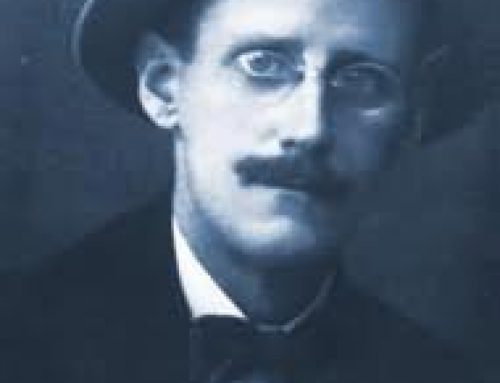The narrative of Ulysses is laid out in 18 episodes, which are then divided into three parts:
I. The first three episodes are devoted to Stephen Dedalus, who represents the intellect, the spiritual, the world of nonform, the negative, the absolute, leaving the “home” of habitual, fixed identities.
II. The next 12 episodes will introduce Leopold Bloom and the sensory world, the world of form (in which Bloom exists more fully than Stephen does), the positive, the relative, and then the eventual meeting of these two “opposites.”
III. The final three episodes constitute their journey “home” together, unity, the notion of “return” and making whole, becoming one.
We are reminded of Joshu’s, “If all things return to the one, to what does the one return?”
Ulysses can also be seen as a voyage from Alpha to Omega, which is none other than the voyage of life, of every moment. Joyce demonstrates this with the following diagram, which appears in his final book, Finnegans Wake:
A………!
?………O
The nine dots on each line refer to the nine episodes in each half of Ulysses. First there is identification, with Joyce establishing an order and putting his characters and the story in place (beginning with “A” and culminating after nine episodes with “!” midway through the book). Then, however, what had been established in the first half begins to become less clear. Here is the question mark in the diagram, as our fixed ideas start to crumble at the hand of Joyce the great artificer. More and more doubt is sown, the ground becomes less and less firm, until eventually we arrive at the open “O” of wholeness and final affirmation of Ulysses. This is not only the shapely “shape” of Ulysses, but also the shapely shape of all of life, moment after moment.
Joyce’s model resembles that of Zen Master Dogen: The “voyage” is accomplished by first establishing positions – identifying mountains as mountains and rivers as rivers, as Dogen said – and then by questioning them, pulling the rug out from under their solidity – mountains are not mountains and rivers are not rivers. Only by throwing into doubt the fixed identities – the way we THINK things are – can we arrive at true affirmation. Only then do we truly see things as they are: Mountains are mountains and rivers are rivers.
— Amy Hollowell Sensei











Leave A Comment